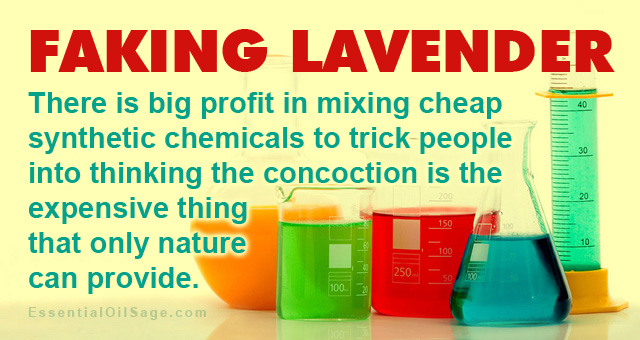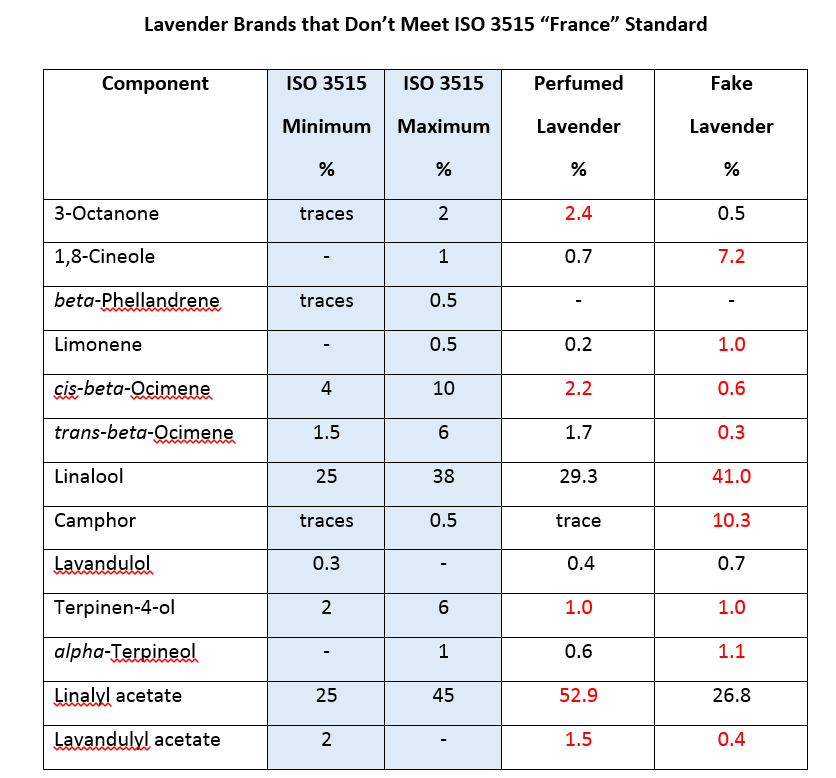
Chemistry bottle image source.
Using GC and GCMS to Investigate the Quality of Different Brands of Lavender
“French export data shows that 250 tons of so-called Fine Lavender are exported annually. The statistics of the association of Lavender growers in Volx show that less than 20 tons are in fact distilled. Ironically, this glaring fraud is obvious to those who can read the gas chromatograms, ostensibly recorded to demonstrate purity. Generally neither local vendor nor customer can read the chromatogram, but both associate proof of authenticity with its sheer existence. In reality most Lavender chromatograms passed around in the marketplace prove adulteration.” Healing Intelligence of Essential Oils by Kurt Schnaubelt. View actual citation.
One technical strength that makes Young Living the “World Leader in Essential Oils” is experienced research scientists who know how to operate analytical instrumentation and interpret the results. We have five research scientists with a combined 180 years of analytical chemistry experience. At Young Living we routinely run GC and GCMS tests on different brands of essential oils (sold by direct sales, retail sales, and internet sales) to examine quality trends. The routine testing of other brands helps demonstrate our Seed to Seal difference.
During routine testing I’ve found several ways that other essential oil brands have manipulated their products. Some brands manipulate “single” essential oils by adding another essential oil to enhance their aroma – I classify these as Manipulated Grade Oils. I’ve uncovered examples of synthetic chemicals added to some brands of essential oils to improve their aroma – I classify these as Perfume Grade Oils. I also discovered some essential oil brands that are totally synthetic (made in a chemical factory) – I classify these as Synthetic Grade Oils.
 In this example, seven different brands of essential oil (sourced from internet, direct sales, and retail sales) labeled as “lavender” were tested by GC. I compared the quality of these brands with the ISO 3515 standard for “true French lavender”. For simplicity I’ve included just two biomarker components of lavender: linalyl acetate and linalool. Three of the lavender oil brands did not pass the required percentage range for these two components (marked in RED). Five out of seven brands failed the ISO 3515 standards based on other GC test components.
In this example, seven different brands of essential oil (sourced from internet, direct sales, and retail sales) labeled as “lavender” were tested by GC. I compared the quality of these brands with the ISO 3515 standard for “true French lavender”. For simplicity I’ve included just two biomarker components of lavender: linalyl acetate and linalool. Three of the lavender oil brands did not pass the required percentage range for these two components (marked in RED). Five out of seven brands failed the ISO 3515 standards based on other GC test components.
These GC test results demonstrate that the quality of true lavender essential oil cannot be determined merely by the look and color of the label, or by the marketing story posted on the internet, or even by its “flowery” aroma.
At Young Living we analyze every lot of lavender through a series of analytical tests to verify that it is “Genuine Grade” quality. I’ll share more with you on lavender quality tomorrow.
Source: Dr Cole Woolley, June 18, 2015
 Now I’d like to show you another trick that perfume manufacturers play to create “perfumed” essential oils. This trick has been played for nearly two centuries on consumers. Perfumers add synthetic chemicals to essential oils to enhance their aroma. My responsibility as a Young Living’s Seed-to-Seal ambassador is to shed light on these “perfuming tricks” to protect our Young Living members.
Now I’d like to show you another trick that perfume manufacturers play to create “perfumed” essential oils. This trick has been played for nearly two centuries on consumers. Perfumers add synthetic chemicals to essential oils to enhance their aroma. My responsibility as a Young Living’s Seed-to-Seal ambassador is to shed light on these “perfuming tricks” to protect our Young Living members.
To understand this synthetic chemical trick from perfuming manufacturers, I need to show you the GCMS analysis of a synthetic chemical additive. For lavender essential oil I chose to analyze the synthetic version of linalyl acetate. Though Linalyl acetate is a “natural” molecular component of lavender and other essential oils, there are chemical companies that manufacture the synthetic version in chemical factories.
The GCMS has its strengths and limitations. The GCMS strength is to provide molecular identification of hundreds of separated components in an essential oil. However, GCMS cannot determine if the molecules detected are natural or synthetic. So, as experienced analytical scientist, I look for chemical by-products of the synthetic chemical additives in question. In this case, I looked for the synthetic by-products of the chemical additive Linalyl acetate.
As lavender essential oil should contain 25-45% Linalyl acetate to be considered “true lavender”, a common trick of the perfume industry is to add synthetic Linalyl acetate to increase the “floral” aroma of lavender. Let’s look at the chemical by-products of synthetic Linalyl acetate. These chemical by-products act as molecular markers to signify that synthetic Linalyl acetate was added.
I purchased synthetic Linalyl acetate from a chemical company named Fluka. Then I analyzed the synthetic Linalyl acetate by GCMS to determine the synthetic by-products. Beside the large percentage (97%) of synthetic Linalyl acetate, the remaining 3% was composed primarily of 8 synthetic by-products.
Source: Dr Cole Woolley, August 20, 2015

I examined seven other brands of lavender essential oil for evidence of added synthetic Linalyl acetate. One brand contained all eight so we can assume the synthetic by-products of synthetic-grade Linalyl acetate. Therefore, synthetic Linalyl acetate was added to this brand of “perfumed” lavender.
Yesterday I showed you the GCMS analysis of synthetic Linalyl acetate from the chemical company Fluka. I revealed the eight synthetic by-products of synthetic Linalyl acetate found in this Table. Finding these eight synthetic by-products in a brand of lavender was no surprise to me.
Six of the eight synthetic by-products were identified as oxide functional molecules. They represent three sets of twin-like oxide isomers: an oxide pair of synthetic by-products at 24.17 min and 24.25 min, another pair of synthetic oxide isomers at 25.76 min and 25.82 min, and a final set of synthetic oxide isomers at 29.10 min and 29.15 min.
The other two synthetic by-products were tentatively identified as Linalyl acetate chemical derivatives based on their mass spectra.
The label on this brand of “perfumed” lavender did not say “perfumed lavender”, just “lavender”. The marketing story promoting this brand of lavender claimed it as being pure, unadulterated lavender essential oil without synthetics. I find it difficult to trust the marketing claims for most lavender essential oils, since five of the seven brands of lavender tested did not pass the ISO 3515 quality standards.
Young Living’s GCMS instrument has been very handy in examining the quality of other brands of lavender essential oil. Can you imagine how I feel about the questionable quality of these other brands of essential oil?
Source: Dr Cole Woolley, June 30, 2015 and August 21, 2015
THEY have Perfume Grade
- They cannot guarantee high quality.
- They only buy oils from middleman brokers.
- They play tricks with synthetic additives.
- They enhance the aroma by adding synthetic perfume chemicals.
- They mismarket and mislabel Perfume Grade as if it’s the highest quality Genuine Grade.
- They get on Facebook to mislead the Public.
- They can’t tell the truth. So why trust them?
I’ve received many questions regarding the LOWER quality essential oil grades: Manipulated, Perfumed, and Synthetic.
We know THEIR main motives: Create unique high-impact aroma to please unsuspecting customers AND money-money-money.
EXAMPLE: One of Their very common TRICKs is to manipulate and perfume lavender oil. This is very TRICKY!!!!! A key “lavender aroma” component of natural lavender essential oil is Linalyl Acetate. Unfortunately THEY add a natural/synthetic chemical to natural lavender essential oil. They TRICK you nose!!!!!!

Here’s how they do it…
1. They source natural Linalool from the steam distilled essential oil of howood. Howood is grown in southeastern China on large farms. Howood and its leaves contain about 90-95% Linalool (the long component colored in light GREEN and Blue). This portion of the molecule is natural.
2. The Linalool is fractionally distilled from Howood essential oil to enrich it’s concentration to 99.9%-100.0%. At this point the Linalool is Manipulated.
3. Now the Manipulated Linalool is chemically modified to add an ACETATE group (colored in YELLOW and BLUE). This is done by adding a Synthetic chemical. The most common chemical additive is Acetic Anhydride. With Linalool + Acetic Anhydride in a kettle, add heat and the 2 combine to form natural/synthetic Linalyl Acetate.
The Linalyl portion of the molecule comes from natural Linalool. The Acetate piece comes from petrochemically-derived Acetic Anhydride. They have created a natural/synthetic chemical to enhance aroma. It is used in so many industries.
This natural/synthetic Linalyl Acetate is synthesized in high quantities in China. It is sold to perfume companies, toiletry producers, personal care manufacturers, and essential oil brokers to add to their products.
Essential oil brokers add the natural/synthetic Linalyl Acetate to steam distilled lavender and lavendin to enhance the aroma and increase the volume. It is common to add 5-10% of this natural/synthetic chemical to Bulgarian lavender. Sometimes it’s added in France and other times in Indiana. Some brokers add 10-20%. It’s a Perfumer’s Trick!!!
The enhanced aroma of this Manipulated/Perfumed lavender smells GREAT!!!! People love the Manipulated and Perfumed aroma!!! That is how THEY sell most of the lavender oil on the market. It’s a TRICK. A Perfumer’s Trick!!!
Source: Dr Cole Woolley, October 7, 2016
Related Posts
